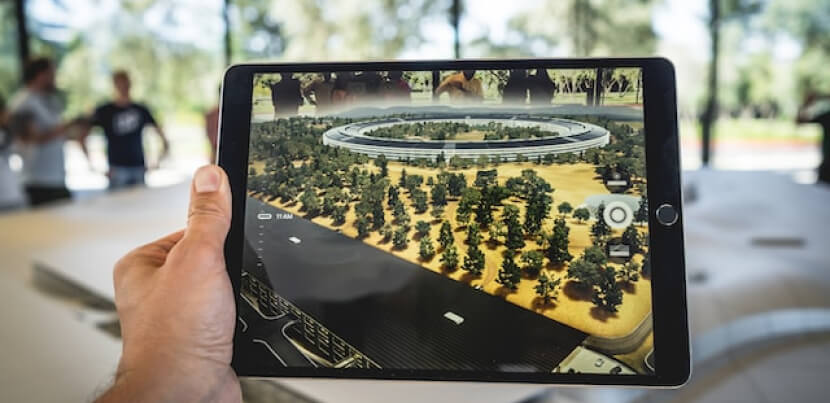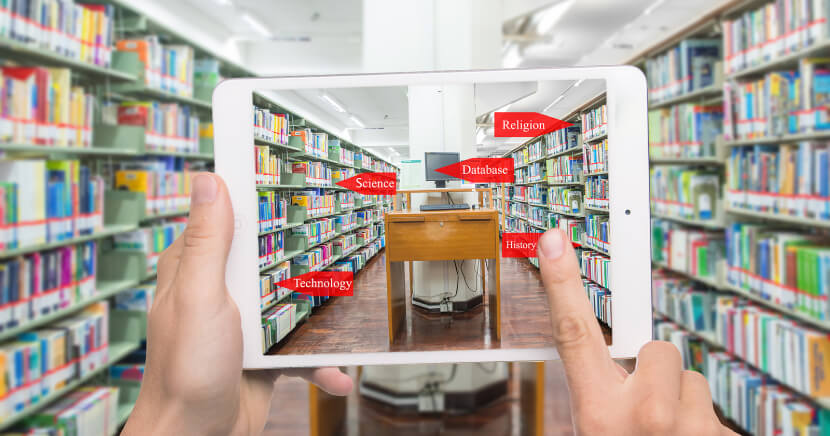Since the dawn of the written word, libraries have played an instrumental role in humanity's quest for knowledge and have driven our species' collective efforts in the dissemination of education and information. The Great Library of Alexandria in Egypt, for example, is still considered one of the most significant man-made structures ever to fall prey to fire.
Over the centuries, the venerable institution has evolved. From stacks of books to digital repositories of knowledge, the humble public library has adapted dramatically in response to changing technology. Libraries are poised to embrace yet another transformative influence more fully: augmented reality technology.
An innovative approach to this emerging tech promises to revolutionize the library learning experience, enhancing education in ways that were hitherto unimaginable.
See also:
-
How digital resources at libraries can create a better experience for patrons
-
Practical, responsible and human-centered: the future of AI in libraries
AR technology augments physical libraries

Most modern libraries underwent a revolution as the internet came into being, becoming a bridge between the physical and digital realms. Augmented reality (AR), as the name suggests, augments this connection by overlaying digital information onto the physical world, creating a seamless fusion of the two.
This augmentation can take various forms, most commonly holographic displays, interactive maps and 3D models.
One notable example of AR in academic libraries comes from the Delft University of Technology Library in the Netherlands, which has implemented AR apps to help users find books and other resources.
Using their smartphones or AR glasses, visitors can simply follow virtual arrows and signs that appear in their field of view, making navigating the vast collection effortless and fun.
Enhancing education with AR in libraries
Education has long been at the heart of libraries. In today's digital world, AR can be a potent tool to enhance the educational aspects of today's libraries, to create engaging learning opportunities and an interactive experience.
For instance, AR can be used to create virtual laboratories, enabling students in disciplines such as astrophysics and medical sciences to conduct experiments safely and conveniently within a sandbox of sorts in the library.
The Singapore National Library typifies this application. It introduced an AR program that allows users to explore the solar system and several other resources in 3D, providing an immersive educational experience that transcends traditional textbooks. Such immersive experiences make learning more captivating, in keeping with the modern preference for visual and interactive learning materials.
AR in libraries: a new chapter in storytelling

Storytelling is as old as civilization, and libraries have long been sanctuaries for literature and narratives. Augmented reality in libraries allows patrons to virtually step into the worlds of their favorite books and explore narratives in a totally unique way.
In the US, The University of Maryland Libraries in College Park harnessed AR's capabilities to create such interactive exhibits and displays. These exhibits provide additional information and multimedia content related to its collections, enhancing visitors' understanding and driving better engagement.
Examples of augmented reality in libraries
Here are some cases from around the world that highlight the diverse uses of AR:
University of California, San Diego (UCSD) Libraries
The prestigious University of California, San Diego (UCSD) Libraries utilized AR to craft immersive virtual tours for students. These tours allow young minds to explore the library's collections and resources in a fully immersive environment.
National Library of Medicine, USA
The National Library of Medicine in Bethesda, Maryland, leverages AR technology to create interactive displays and exhibits. These offer additional information and multimedia content related to library collections, particularly the History of Medicine Division's popular "Doorway to the Past" exhibit.
This thoughtful application of augmented reality provides valuable context and information about historical medical artifacts.
National Library of Korea, ROK
In Seoul, South Korea, the National Library of Korea incorporated augmented reality some years ago to create richer and more interactive displays and exhibits.
An outstanding example is the "History of Korean Medicine" exhibit; it employs AR technology to deliver further insights and information to visitors, besides fostering a deeper understanding of Korean medical heritage.
National Library of Sweden
Librarians at the National Library of Sweden in Stockholm embraced AR to create its beautifully curated and intensely immersive "Treasures of the National Library" exhibit.
Augmented reality in medical libraries
In the context of medical-only libraries, augmented reality presents a remarkable advancement in the visualization and comprehension of complex medical concepts. Its potential benefits include:
-
Enhanced visualization of medical concepts: AR technology can offer interactive 3D models of anatomy and medical procedures. This approach allows medical students and professionals to engage with intricate topics far more effectively. The three-dimensional visualizations aid in comprehending anatomical structures with unprecedented clarity.
-
Efficient access to medical resources: AR streamlines and simplifies access to very specific information about medical resources. By simply pointing their devices at a QR code on specific book or journal covers, users can instantly retrieve relevant information. Such access saves time and facilitates efficient research while benefiting both students and medical professionals.
-
Real-time guidance during medical procedures: Medical practitioners can utilize AR technology to provide real-time guidance during operations and other procedures. Critical information, such as the location of veins or other anatomical structures, can be projected onto a patient's body. This assists medical professionals in performing procedures with extreme precision and heightened confidence.
Does AR have the edge over VR in libraries?

While both AR and VR offer immersive experiences and are constituents of "extended reality" (or XR) technology, AR holds certain advantages for application in libraries. Unlike VR, which entirely replaces the physical world with a digital environment, AR simply enhances the real-world environment by overlaying digital images within the user's view.
Here are some key benefits that augmented reality in libraries has over VR:
-
Better integration with physical collections: AR seamlessly integrates with collections in physical libraries. Patrons can use AR applications to access supplementary information about books, artifacts or artworks while browsing the physical shelves.
-
Collaboration and social interaction: Libraries are also hubs of community engagement and learning. AR encourages social interaction by allowing multiple users to experience digital content together while remaining in the same physical space.
-
Superior accessibility and inclusivity: AR experiences are accessible to a much wider audience, including individuals with disabilities, as they rely on real-world physical elements. Libraries can use AR to provide inclusive learning opportunities where everyone can participate.
-
Cost-efficient: Implementing AR can be more cost-effective than VR, as it often requires fewer specialized devices and can run on standard smartphones or tablets. Libraries can offer AR experiences without substantial financial investments. This aspect is a great leveler as even smaller and rural libraries can join the technological revolution AR promises.
Limitations of AR implementation in libraries

While AR offers several major benefits, it comes with a few limitations and implementation challenges.
Common difficulties libraries might encounter include:
-
Lack of proper technical infrastructure: To fully harness AR's potential, libraries must have robust technical infrastructure. This includes high-speed internet access, XR-compatible devices, and the capacity to handle AR content. Libraries in underserved areas may struggle to meet these requirements.
-
Content creation and curation: Creating and curating AR content tailored to library resources demands time and expertise. Libraries must allocate resources for content development or collaborate with content creators to ensure high-quality augmented experiences.
-
Privacy concerns: AR applications often collect user info, raising privacy concerns. Libraries must establish clear policies for data collection, storage, and usage to safeguard patron information. These concerns are still to be addressed in Europe, where — more than five years after the General Data Privacy Regulation came into effect — few libraries still know what to do.
-
User Training: Both patrons and library staff may require training on using AR applications effectively. Libraries are already investing in user learning and support services to bridge this knowledge gap.
How will AI impact AR usage?
Since both technologies are still works in progress, nobody is quite sure how AR use in public and university libraries will be affected by artificial intelligence.
Most experts believe that large language models and other AI technologies will play a significant role in the libraries of the future. Libraries can leverage ChatGPT, for instance, to provide virtual assistants that guide patrons through AR experiences, answer questions and offer personalized recommendations. This synergy between AR and AI enhances the learning and exploration journey for library visitors.
Moreover, the integration of ChatGPT can extend beyond the library's physical walls. Libraries can offer virtual library services, providing access to resources, research assistance and superior knowledge diffusion through AI-powered chatbots, making information more accessible than ever before. There is great potential for academic libraries in particular to use AI to improve their services.
An ongoing evolution

Augmented reality represents a transformative force in the world of libraries, offering unique advantages over virtual reality, innovative ways to engage patrons and the potential for seamless integration with AI-driven technology tools like ChatGPT and Bard.
While libraries must navigate implementation challenges, the benefits — such as enhanced integration with physical collections and cost-efficiency — make AR a compelling addition to a library's offerings.
The global perspective of the International Federation of Library Associations and Institutions (IFLA) strongly underscores the importance of shared experiences and collaborative efforts in the adoption of AR:
While AR is still relatively new in the library domain, the rapid pace of technological advancement suggests that the implementation of AR in libraries will continue to accelerate, ushering in a new era of engaging and interactive library experiences.
More and more libraries around the globe are joining the AR revolution, and this technology holds the power to redefine the future of knowledge dissemination, education and community engagement. Augmented reality in libraries is writing a new and promising chapter in the ongoing story of an ages-old institution.
As libraries harness the power of augmented reality to create engaging, interactive and educational experiences for their patrons, services like PressReader play a pivotal role in bridging the gap between the physical and digital worlds. This integration not only enriches the library experience but also empowers users with a wealth of knowledge at their fingertips, further solidifying the library's position as a hub for learning, exploration and innovation in the digital age.









